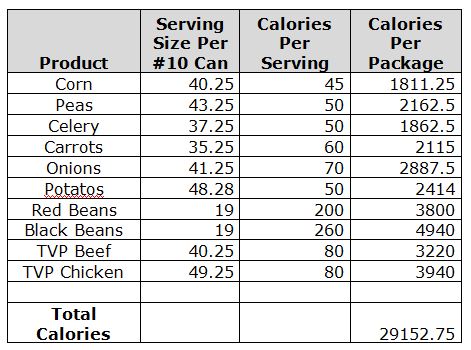Most liberty-minded folks believe that the “bad times” are inevitable. Most of us want to be prepared for whatever those “bad times” really mean. A large number of us never prepare.
There are lots of reasons why folks don’t prepare.
- Some don’t prepare because they aren’t sure what to prepare for.
- Some (probably most of us!) are on limited budgets.
- Most of us suffer from “prepping” fatigue. (It’s funny – a well known site that promotes “Prepper Shows” suggests that we should call it “survivalism” because “prepping” has too many bad connotations!) There is just too much information out there and much of it has virtually no application to most of us. It is very easy to be overwhelmed and do little or nothing.
Many in the liberty movement don’t make it easier for us. There are many web sites out there telling us what the one single thing is that will make us “winners” in the fight to restore liberty.
Some of what is out there is legit and good info. Sadly much of what is out there is written by people who merely want to make money off the backs of us in the liberty movement. On the one hand, that is kind of neat. We’ve become a market that folks recognize and want to target us for sales. On the other hand, there is a lot of useless junk out there that is incredibly overpriced.
No one knows what will precipitate the upcoming troubles. No one. Some ascribe to a huge government crackdown on the citizenry. Others fear an invasion by a foreign power such as China, Russia, ISIS, the UN, etc. The theories abound. Certainly the actions of our Government in the last 50 or so years have driven us to the breaking point.
At the end of the day though, the threat that you plan for needs to be broken down into the short term, intermediate term and long term.
For most of us, we usually start with the long term threat, namely a complete breakdown of the government as we know it with either an internal civil war or a war against foreign aggressors on our homeland. We try to plan backwards.
And for most folks, that’s where they stop. It just looks too big to handle.
We’re all on limited budgets, have limited time, and quite frankly limited skills. We can’t all move off the grid to some magical “safe spot”. We can’t all possibly learn everything that is needed.
I suggest that we need to start with the short term threat. If you can’t survive the short term threat, it really doesn’t matter that you were prepared for the intermediate or long term threats.
You need to survive for 90 days.
You need to have food, water and the means to protect it for 90 days.
Until you have these basic preps, you shouldn’t spend a dime on any other preps. Having a ham radio that allows you to talk to the world doesn’t help you if you don’t have food or water. The best generator in the world is not edible. An arms room full of tons of guns and bullets doesn’t help you if you run out of food and water.
So what does the 90 days look like?
I predict that an unnatural disaster will cause a nationwide breakdown of society. Lots of things could cause it, but I think the most likely cause will be the loss of food. EBT card breakdown would be the most catastrophic, but it could be massive rioting causing stores to stop resupply.
Note, this is just one of MANY possible reasons for societal breakdown. Your threat analysis may vary!
No food will cause massive unrest. Violence will be terrible. Quite frankly those who will cause the violence will probably descend to killing each other very quickly. Roving bands of violent thugs will wander throughout cities and they will destroy what they can in an attempt to get their own food and water.
And what of Federal, State and Local law enforcement? Sadly, most of them will be used to guard what the Federal, State and Local governments want protected. Much of it will be critical infrastructure. Lots of it will be guarding the “elites” in government.
THE FIRST 30 DAYS
The first 30 days will be violent, with much random killing. I estimate that anywhere as many as half of the population will be killed, many of them the thugs and the remainder innocent folks who got caught up in the violence.
Our mission in the first 30 days is to survive. It’s time to “hunker down”. Note, I don’t recommend “bugging out”. We can discuss bugging out on a different occasion, but I believe that in the first 30 days the random violence will get you killed if you are out and about.
I don’t think anyone should leave their safe space during these 30 days. Blacked out windows, decoy trash in the front yard, vehicles up on blocks, etc., will help keep you from being a target and victim. Not looking like a target will increase your chances of not being a target. Lights visible from the road, a roaring generator, the aroma of food cooked on the grill are all things that will attract attention.
The minimums you must have are non-perishable food, water for drinking and sanitation, a mechanism for handling human waste, and of course the means to protect these things.
EVERYTHING else is bonus at this time.
Yes, it would be nice to have IR wireless cameras to watch your perimeter. It would be nice to have shortwave radios to listen to the news. It would be nice to have ham radios to check on friends. It would be nice to have solar chargers, storage batteries, inverters and the like to keep your phones and laptops operable. The list of “nice” things goes on and on.
But, if you aren’t eating or drinking, it doesn’t matter.
DAY 31 TO 60
The second 30 days will be different. The thugs that are left will be the stronger ones. They survived. They will be more violent and far more desperate. They have run out of all things that they need. They will be a little more organized, but probably in small groups/gangs. By this point most of them will be on foot. With no gas stations and roads/highways cluttered with wrecks, burned out vehicles and vehicles merely out of fuel, rapid transit won’t be easy.
These smaller gangs will target what they believe to be opportunities to get food, fuel, water and arms/ammunition. They have the challenge of food and water just like we do. Imagine a 20 mile hike with nothing for them at the end.
With the smaller numbers of thugs, the Government will begin conducting operations to restore law and order. I imagine it will be with overwhelming force, city by city, with a combined State National Guard, State Police and Local Police. They won’t be able to be everywhere at once, so the restoration will not be automatic. A good percentage of these forces will still be used to protect what the Government thinks is important (important to them, not to you).
During these second 30 days, it may be possible for you to venture outside. I would only do it in daylight and only in groups. At least two vehicles with four armed people in each vehicle. If your area is part of the restoration operations, I probably would stay off the streets. Shoot to kill really means shoot to kill.
As in the first 30 days, our Government will not have the resources to target the good guys. They will be struggling to survive and protect what is theirs.
DAY 61 TO 90
During the third 30 days I think we will see efforts to restore services. Electricity will start to work. Water will start to flow. Stores that still exist will start stocking food, fuel and other essentials. It won’t be universal, and it won’t be easy.
I recommend taking advantage of what is available and attempt to restock my supplies. I still wouldn’t venture out by myself. Perhaps smaller groups but still in multiple vehicles. If you haven’t shaved or cut your hair in a couple of months, I probably would. You want to look like a civilian who needs resupply, not an armed thug. Just because we survived the 90 days doesn’t mean it’s going to get better.
Our country’s population will be smaller at the end of 90 days. Merely cleaning up the devastation and dead bodies will take many months. Heck, some places may never come back.
Our Government will make plans to insure that something like this doesn’t happen again. Change will happen and as always many will attempt to take advantage of the crisis to make changes that we won’t like. Our Government will have more time on their hands to screw with us, the good guys. But, we’ll be alive to try and influence that change.
We’ll all have some serious “lessons learned” from these 90 days. Things we wish we had done different or better. Our mission remains the same. Restock and work on the next 90 days. Smarter, wiser and alive. Armed with what we learned and with what others learned, we’ll probably do it a little different. Resources will be shifted to the next phase of survival.
By the way, this 90 day plan is just that, a plan. Unrest isn’t like a football game. You won’t know when the game starts, there will be no halftime, and there are no four quarters. The length of each phase will likely vary. There may be overtime. You can watch for indicators of when it will start, but based on experience of social unrest localized unrest can grow very quickly.
Part Two of this series will discuss food. Part Three will discuss water and sanitation. Part Four will discuss how to use deception to hide the fact that you are alive, well and capable of surviving. Future parts after that will discuss how to accomplish the “nice” things on a budget.







